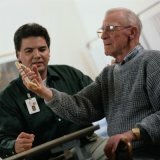Symptomatic epilepsy
 Symptomatic epilepsy is a pathology that has in the structural plan a symptomatic complex of epilepsy, like all its subtypes. But the emergence of it is not genetic or innate, but acquired. Symptomatic epilepsy is a little less common in comparison with its cryptogenic form, but everything is also quite uncomfortable and not less known.
Symptomatic epilepsy is a pathology that has in the structural plan a symptomatic complex of epilepsy, like all its subtypes. But the emergence of it is not genetic or innate, but acquired. Symptomatic epilepsy is a little less common in comparison with its cryptogenic form, but everything is also quite uncomfortable and not less known.
Symptomatic epilepsy itself is not very different from idiopathic in the clinic. Its difference is the cause, and all the types of symptomatology do not differ. Epilepsy is a very extensive pathology and has a multifaceted manifestation. The person does not foresee the presence of epilepsy, because many of her subspecies manifest themselves as symptomatic not entirely characteristic.
Symptomatic epilepsy: what is it?
Symptomatic epilepsy manifests itself as a polyethological, partly progressive, neuro-systemic psychiatric illness in its final stage, which manifests itself as a variety of convulsive, and often unconvulsive seizures and similar conditions, which is paroxysmal in nature. Conducts to specific changes in the person and in particular her personality, epileptic psychosis, specific non-classical puzzlement. Epilepsy is a form of disability of the brain, its functioning and is a very common pathology. Regardless of any ethnic, country-related symptoms, epilepsy occurs in one percent of people. Approximately 6% of individuals had at least once a seizure, which, according to etiology, is similar to epileptic. A characteristic sign of epilepsy is the onset in childhood, well or adolescence, but symptomatic epilepsy begins after a clear cause that has an exact beginning in time.
For a rational understanding of terminology in the context of epileptic disease, it is important to understand some conditions. An epileptic reaction has a characteristic of a seizure or an unconvulsive seizure, which occurs as a general biological response to an external stimulus. There is a widespread use of the diagnostic syndrome epileptic syndrome - these are paroxysms that can have not only convulsive components, but also the symptoms that are part of the disease structure that have a connection with organics in the GM along with other neurologically conditioned and psychopathological symptom complexes of the underlying disease.
Variants of symptomatic epilepsy : epilepsy based on the transferred pathologies of the organic genesis of the lesions of the GM, completed before the time of symptomatic epilepsy;Epileptic syndrome of active progredient states and cerebral processes. In this case, epilepsy is established as concomitant.
Epilepsy is a massive disease that has a mass of subspecies and is characterized by a clear localization due to which it is possible even to determine the location of the epileptic focus. Generalized or general seizures occur with the disconnection of clarity of consciousness. They include large seizures and small convulsions. Small have many subspecies, depending on the manifestations. The so-called threatening state as an epileptic status is also referred to generalized.
Focal or focal seizures are also very common, not always distinguishable and have their own clear classification. All of them pass without loss or lack of awareness. Motor small seizures are as follows: according to Jackson, adversive, chewing, muscle postural and myoclonic. Sensual seizures: somatosensory, visual, sniffing, auditory, taste. Mental seizures: short-term psychoses, twilight of consciousness, special states in the form of dysphoria, as special kinds of anger;Epileptic psychosis. Automatisms, according to the type of brief defilements: trance, fugue. Vegeto-visceral seizures. Conversational seizures: attack loss of articulation, aphonic. Reflex attacks are a separate species with special symptom-complexes.
Causes of symptomatic epilepsy
In the development of symptomatic epilepsy, a number of diseases play a dominant role.
Secondary symptomatic epilepsy comes from the fact that there is a primary disease, which provokes the hearth. Neoplasms, especially in the GM are often able to provoke epileptogenic foci. Any infections, especially those having access to GM: a brain abscess of streptococcal, staphylococcal, meningococcal. Meningitis with cerebral symptoms as encephalitis with focal symptoms also can lead to such deplorable consequences, the etiology of these pathologies is different from the virus, herpes virus, cytomegalovirus, encephalitis and others. TBI and generic injury and is capable of giving such symptoms as a stroke orAny acute conditions. Individual anomalies that have arisen congenitally, malformations, in the form of softening of brain particles, and sometimes vessels. Often, a variety of dyskinesia, bookmarks also can lead to a similar problem. Many rheumatological pathologies can produce such effects or as a side effect of individual medications. Multiple sclerosis, as well as fetal hypoxia or antenatal capable lead to symptomatic epilepsy if not more lethal effects. Many pathologies of metabolism, especially of hereditary origin.
symptomatic epilepsy alcoholic origin - it is quite it is not a rarity, but not limited to ethanol can lead to such an outcome, but also a host of other toxins and drugs, especially methamphetamine, cocaine and ephedrine. Many drugs also have a side effect in the form of symptomatic epilepsy, many antipsychotics, individual antidepressants and bronchodilators. Antiphospholipid syndrome, like other metabolic syndromes, can lead to such consequences. Toxins and poisons can also give similar attacks, poisons poisoning, heavy metals, especially lead and mercury, gasoline, barbituric drugs. Infections with somatic effect, can also provide some seizures, especially with hyperthermia: tuberculosis, malaria, typhoid fever, chicken pox, measles, etc. set organ failure, particularly liver, kidneys and pancreas..
In addition to the triggers themselves, which cause this pathology, there are risk factors. Secondary symptomatic epilepsy is provoked by exposure to several factors that affect nerve cells. Influence have: a violation of the conductivity of neurons, an increased tendency to edema, pregnancy problems, medication intake, hypoxic inclusions;Malnutrition, as well as a violation of the concentration of any metabolites in the body. Stresses, as well as incorrect difficult conditions of work can also become a kind of provocateurs for the development of this type of epilepsy.
Symptoms and signs symptomatic of epilepsy
diagnosis of symptomatic epilepsy has clear criteria according to ICD 10. Organics, leading to impairment of the GM, for example due to head trauma, neuroinfections. To make a diagnosis it is important to find the cause. Seizures have a characteristic frequency, a mechanism of development - hypersynchronic neuronal impulses and discharges in certain areas of the brain. The presence of twilight and similar psychosis. Affective mood disorders, by type of dysphoria. Presence of permanent disturbances of mental manifestations, specific personal modifications, formation of dementia. For a progressive, that is, some other seizures alter, change form person a specific person, dementia, the dynamics leads to epileptic psychoses. On EEG foci, which increase in magnitude and change as the epileptic focus develops.
Symptomatic partial epilepsy of is manifested by simple epileptic seizures. This is a separate twitch. Symptomatic partial epilepsy with motor seizures looks like twitching in the arm or leg, sometimes the spasm passes from the distal part of the limb, capturing more of the body, and can even reach loss of consciousness. Symptomatic partial epilepsy can also be manifested by psychosensory seizures appearing in different analyzers. Personally it seems that her body has changed, that the objects around are twisted and twisted. Sometimes even paroxysms of the fictitiousness of the surrounding or of oneself may arise. There are also seizures with psychoemotional disorders. Afatic with complete absence of speech, difficulty in pronouncing words with complete integrity of muscles. Dysmnestic with the presence of characteristic psychosensory disorders, a type that has already been seen before or never seen. There is also an attack with mental infidelities, when the only complaint is a change in the flow of thoughts, sometimes aggravated to illusory and hallucinatory with the same name disorders.
Symptomatic temporal epilepsy of is formed when the ammonium horn is affected and is characterized by a polymorphic pattern with a variety of abnormalities. Symptomatic temporal lobe epilepsy has its own focus in the temporal cerebral lobe and it is it that provokes epileptoid activity with the appearance of symptoms. Symptomatic temporal epilepsy is provoked when the median structures are damaged and sclerotized. Most often begins imperceptibly, first aura, a type of unpleasant feeling or headache. But with the days and times complex complex manifestations with seizures and personality changes can occur. Symptomatic temporal epilepsy progresses, subsequently leads to convulsions with loss of awareness and absences.
Symptomatic epilepsy in children
In the children's age category, there are some difficulties with pathologies of different systems, like epilepsy. Diagnosis is complicated, especially at a small age, as is the difference in the causes of seizures. Children in general have a convulsive alert, so worms, fever, allergies, and other diseases can provoke cramps.
Epilepsy at a young age does not begin with massive seizures. More often it is absences - turning off awareness for a few moments without losing muscle tone. Children are characterized by a dream, which can be the first bell for the suspicion of epilepsy. Sudden mood disorders, like attacks of pain in different organs and in unreasonable cases, even rumbling in the abdomen can speak of epilepsy. Suddenly arising fears, often causeless and inappropriate situations are also the first symptom.
For children there are special syndromes that speak of an unfavorable prognosis. In general, symptomatic epilepsy from childhood is prognostically unfavorable.
Vest syndrome is a triad: children's spasms with nods and pecks. Psychomotor development is exacerbated and inhibited, the EEG key changes. There may be rapid extension. It is characteristic for babies, more often boys. The prognosis of symptomatic epilepsy in children who are being treated with Vest syndrome is unfavorable. It is characteristic in the presence of organic matter.
The Lennox-Gastaut syndrome manifests itself after two years and basically flows from the previous one. The occurrence is provoked by encephalopathy. It includes atypical absences, nodal seizures, falls due to a violation of statics, tonic convulsions. Often they can acquire serial flow up to the epistatus. Very quickly, dementia is increasing, coordination is suffering. Therapies practically do not lend themselves. The prognosis of symptomatic epilepsy is unfavorable with this syndrome, because there is a high resistance to stopping therapy and rapid progression, which manifests personality changes.
Children with a history of symptomatic epilepsy have an anamnesis. For the onset of seizures at such a young age, there must be a perinatal pathology, that is, in utero and in the process of delivery there could be the presence of unfavorable and dangerous factors that can provoke seizures. Birth trauma is also an impressive factor, because hypoxia and similar conditions can lead to irreparable consequences. Tiny must certainly be protected, because infections and injuries in the first year of life can also lead to epileptic seizures.
Symptomatic epilepsy in children is not much different from classical, just the realization that it could be avoided, if you take a closer look at a pregnant woman, is very upset. Therefore prenatal diagnostics and calm gestation are important. All this in the subsequent will deprive a lot of problems.
Diagnosis of symptomatic epilepsy
Symptomatic epilepsy always has a history of heaviness, that is, by asking the person thoroughly, it is possible to find many tips for yourself. Always there is in the past such individuals have some kind of trauma, illness, operation, dependence or something similar. You can find obvious signs of this, for example, scars, traces of needles. In the children's age category, the presence of nuances during childbirth or in the postpartum period. It is important to distinguish this disease from others with the presence of convulsive seizures. Epilepsy has a sudden onset of the seizure, but can first have an aura that serves as a kind of precursor. External causes of the onset of seizure can not be detected. But it can provoke some triggers, for example stopping the use of anticonvulsant treatment, sleep deprivation, alcohol intake. Also less massive, but more frequent due to their spreading can be temperature, allergens, sharp stimuli, sound, aromatic, stress, agitation, excessive intake of liquid or sugar substances.
Before the onset of the most symptomatic epilepsy, the pathologies of her series may appear: migraines, night terrors, apnea, enuresis. Also, typical signs of an epileptic fit include an aura, a fall, regardless of location, if this is a great fit. The person with cramps changes color, at first turns pale, then becomes cyanotic. Pupils do not react during an attack, the patients very often bite their tongue. At examination even ask to show language, after all presence of scars confirms presence of an epilepsy. Very often there may be feces against the will of the person. Seizures are photographically similar, that is, one is similar to the previous one. The seizure has a clear sequence, first a loss of consciousness, then a fall, a tonic, then a clonic convulsion, a coma, a sopor, a stunning. Typical acute episodic oligophasia, an absolute loss of awareness during an attack. Amnesia after the attack is complete. The seizure lasts from half a minute to two minutes. There may be pyramidal symptoms.
Complete psycho-emotional and medical examination includes the collection of information, an anamnesis of a patient's life, an anamnesis of the disease. With epilepsy, it is very important to describe seizures, because it gives the person the right to have a disability group. Obviously, a general and neurological examination is conducted, an indicative EEG.Typical for EEG will be a sharp wave peak, slow waves. In some neurological examinations, an MRI is also performed to identify foci. The purpose of the survey is to identify the causes. Also need to find mental disorders, which often accompany. For this we use a conversation, as well as psychiatric questionnaires: Moko, MMSE, scales and definition of intelligence.
Treatment of symptomatic epilepsy
Epilepsy is a complex affair. Important is a dehydration diet with low consumption of liquid and sweets. The drugs that are shown are anticonvulsants. The basic ones in this case are valproates: Depakin, Depakin eteric and chrono, which is also normotime, Convulex, Convulsovin, Enkorat. Carbamazepines, older and cheaper drugs now go to the second row: Tigretol, Finlepsin, Carbamazepine. Lamotrojine, Lamyctal have a broad effect, taking 70 mg. Topiramate is a modern anti-epileptic which is well used for refractory epilepsy. To this group include Topamax, Oscarbazepine, Levitracetam. It is very important to select a dose with a regular application, which will prevent such negative manifestations. After all, with each fit, a part of the neurons die.
With the epistatus, massive therapy and dehydration are used - Manit, Tiogama, Cytoflavin, Lasix with glucose, Magnesium sulfate, Prednisolone, Essentiale. With the addition of psychotic phenomena, Trifluoperazine, Zuclopentixol, Clopixol, Triftazin, Fluanxol, Diazepam, Clozapine, Paliperidone, Ziprasidone, Amisulpride are added.
With the inclusion of depressive symptoms can apply: Fluoxetine, Paroxetine, Lamotrigine. If there is an exacerbation of psychotic symptoms, then we add Quetiapine, Sertraline. The duration of the stabilization period is up to six months. For cognitive moments apply Nimodipine, Gliatilin, Donepezil, Piritinol.



